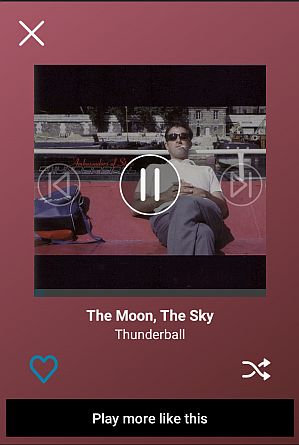Music service Rhapsody introduced Rhapsody AUTO on Friday, and we gave it a test drive (double meaning, there) over the weekend. Rhapsody AUTO has rolled out to Android phones; iOS “coming soon.”
 There’s a lot right with this new feature, designed as an in-car version of the Rhapsody app. We like it that Rhapsody has taken auto safety into its own hands, even as cars are starting to roll out with Google Android, Apple CarPlay, and other digital dashboard solutions that provide safer versions of app control. New dashboards are in a small minority of cars, and most people who use music apps while driving are plugging their phones into the dashboard and controlling the phone directly. That is categorically dangerous.
There’s a lot right with this new feature, designed as an in-car version of the Rhapsody app. We like it that Rhapsody has taken auto safety into its own hands, even as cars are starting to roll out with Google Android, Apple CarPlay, and other digital dashboard solutions that provide safer versions of app control. New dashboards are in a small minority of cars, and most people who use music apps while driving are plugging their phones into the dashboard and controlling the phone directly. That is categorically dangerous.
(It’s not the first time Rhapsody has taken matters into its own hands rather than relying on third-party solutions. TrackMatch is a music-ID feature with the same core function as Shazam and SoundHound, ID’ing songs from another source and bringing up those tracks in Rhapsody. Likewise, an on-board equalizer obviates the need for tuning the frequency balance with an outside control.)
The screen design of Rhapsody AUTO is big, bold, simplified, and easy to control without a lot of squinting and fiddling, as one might expect.
A couple of additional tweaks make it less likely that the driver will need to reach for the phone. first, an opt-in setting automatically downloads all tracks which are assigned to the AUTO section. With the driving library of music locally stored, a spotty Internet connection won’t put gaps in the music, causing the drive to pick up the phone to see what’s wrong. Also, any playlist started in AUTO mode is on auto-repeat. No silences there, either.
Skipping, a function that remains desirable during in-car listening, is accomplished either with a swipe of the large-sized album art in AUTO mode, or by touching a fairly big arrow icon. Touching elsewhere on the artwork pauses the track.
With all this goodness, there is one forgotten aspect of driving with a music app which Rhapsody could not address — activating the screen after the phone times out. On most phones, bringing the screen to life requires fumbling with the device and finding an edge button. Then, if security is enabled, a password must be typed or a swipe code drawn on the screen. In our judgment this is one of the most dangerous aspects of operating a phone in a moving vehicle.
Android does not natively allow the screen to remain “on” indefinitely — a definite bug in what should be a user’s choice. Drivers using Rhapsody AUTO can lengthen the”on” time to 30 minutes, which is helpful, but a manual setting that is more preferable when driving than at most other times — forgetting to set it back to a shorter time-out drains the battery.
Keeping the screen “on” when driving is a use-case that Google should address … and then app builders should take advantage of. Rhapsody AUTO goes as far as it can for safety. But lighting up the screen and swiping a security pattern remains a dangerous aspect of driving with an interactive music service.
